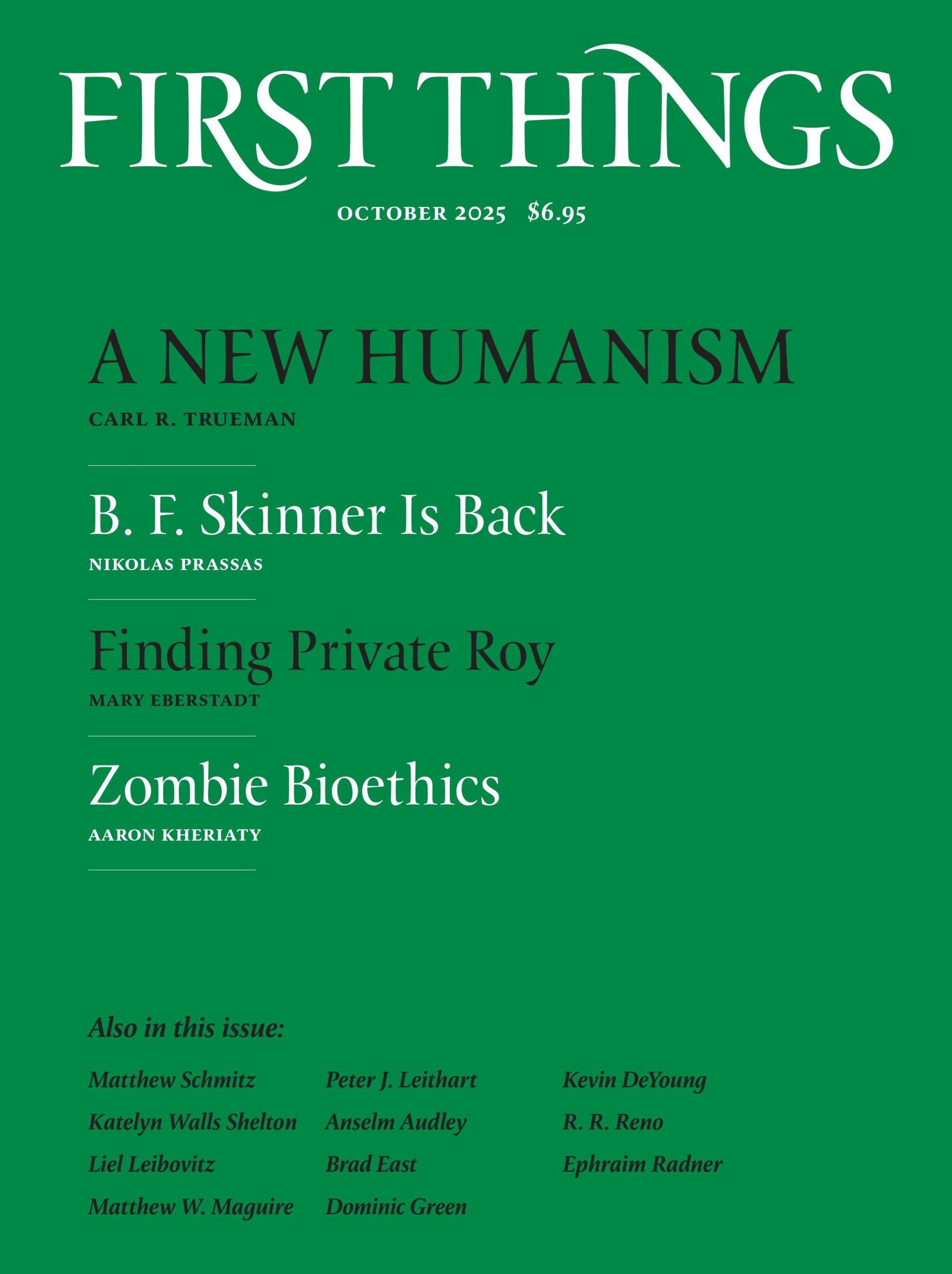
St. Augustine remains the Church’s greatest preacher. A single sermon of his can roam in many directions. That is a marvelous virtue, because it reflects reality: God’s glory is beheld in the breadth of the world, given to us in the breadth of Scripture. The homiletic habit of today—one point, please!—can be an enemy of divine beauty, the oratorical devolution of Benjamin Jowett’s dictum that any given text in the Bible has only “one meaning.” How wretched!
I recently revisited Augustine’s sermon on Luke 10:38–42, the story of Martha and Mary. Unlike many sermons I have heard on this text, Augustine doesn’t issue a simple imperative: Don’t be like Martha distracted by work; rather, contemplate Christ’s teachings or rest with him in prayer. It turns out, says Augustine, that we embody both Martha and Mary—indeed, we must. The two sisters are parts of our one life, the life that is “here” and the life that is “coming.” As always with Augustine’s sermons, there are examples and references to various aspects of his listeners’ daily life—their questions, challenges, pitfalls, and worries. Instead of pruning their concerns, he lets Mary and Martha illuminate it all. Life encompasses both anxious working and attentive resting. These are integrated in the singular life of Jesus, who works as a “servant” like Martha, just as he fulfills that labor and offers it to us in the restfulness of Mary. The vast world is taken up in the Messiah. It is a beautiful sermon.
A sermon should be its own microcosm, taking in the world and presenting it back to us in turn. After all, the world is God’s: “The earth is the Lord’s, and the fulness thereof; the world, and they that dwell therein” (Ps. 24:1). Thus, in a good sermon, what is truly beautiful—the “beauty of the Lord” (Ps. 27:4) in all its perceptible glory—will unfold before our eyes and in our hearts as they behold a clear vision of God’s handiwork, revealed in his Son.
The world is vast, of course—and so, too, is a beautiful sermon. Augustine is hardly a craftsman of the infinite. For no sermon—or poem, or book, or treatise—could ever reach the measure of such a truth as God’s creative being, his gift-giving of our lives. Still, most sermons don’t even try. The issue is not the absence of well-turned rhetoric. There are many fine speakers in our churches. But their sermons, for all their nicely framed oratory, their winsome stories, their punchy demands, are nonetheless too deliberately small: at best unattractive and at worst ugly.
We usually assume a sermon should have a “message,” whether doctrinal, moral, or political. Try to do that, avoid this, understand that. Any of these messages can (and should) be true, true enough in the context of their limited scope. Get the relation of the Son to the Spirit right; define self-control well in this or that situation; be faithful in such a way. None of this, however, constitutes the world, God’s world. These messages point only to bits and pieces, threads pulled out from a rich tapestry. Their colors are muted, and their purposes, in their isolated incompleteness, opaque. Unraveling the threads of life into discrete lines renders the world a drab place indeed. One reason I read less and less theology (and wilt more and more at sermon time) is because so much of it has left the world behind. What’s offered are only dregs.
Consider another story from Luke’s Gospel, the woman washing Jesus’s feet with her hair (7:36–50). Modern sermons on the topic pick out one true thread of the story: salvation through faith rather than works; Jesus’s atoning sacrifice symbolically rendered; love engendered by divine forgiveness; narrow-minded judges of others; no one is excluded from God’s mercy. Augustine’s sermon on the text gets most of these topics in—all of them, in fact, as far as I can tell. His are not one-point sermons. In fact, he adds a lot more: hedgehogs and hares, the nature of the Church, heresy, ignorance, mission, and even the woman’s hair (which intimates the transience of possessions, mortality, eternity). Yes, there is a lot there. And, of course, as Augustine lays things out, other texts of Scripture proliferate, from the New and the Old Testaments, from psalms and epistles.
This last point is important. While Augustine’s sermon perhaps seems rambling to modern ears, because it doesn’t latch onto one thread, his forays among the words of Scripture are precisely what opens the sermon up to the larger reality of God’s work in the world. So much in one story. So much of God, and thus so much more beautiful. It is not the case that the more Scripture is quoted in a sermon, the more beautiful it is. Still, scriptural proliferation is always better than scriptural parsimony. There is, after all, a metaphysical force in play here: The Word works; so, too, do the Word’s words. “His work is honourable and glorious” (Ps. 111:3).
Preachers who agree with this in principle are rightly concerned, however, that listeners have limited capacities in the face of scriptural proliferation and of the vast world it unfolds. Let’s stick to one point, they think, and make use of a few well-chosen citations, if needed. Even better, let’s illustrate the matter with a good story that “brings the point home.” Maybe something from my childhood.
The concern about saying too much is well-founded. We live in an ugly time, and we are inured to ugliness. True beauty is hard to swallow. But the answer to this problem is not to dish out more ugliness. Rather, we must train ourselves in beauty. The world must be opened up, bit by bit. And Scripture does this best. Preaching on the lectionary’s multiple readings—not just one—is a good way to begin. Let the words of one lesson knock upon the door of another’s—and then let us be so bold as to open it just a little and discover what comes rushing in and out.
Luke 7:36–50 comes up in many churches’ weekly lectionary, paired with 2 Samuel 11:26–12:10, 13–15, which pertain to David’s adulterous and murderous affair with Bathsheba and the child he conceives from his criminal lust. There are sexual allusions here, as well as intimations of horrendous violence, wretched loss and mourning. Read with Luke 7, these verses from Samuel give new depth to the woman washing Jesus’s feet with her hair and tears, weaving together multiple threads: disobedience, self-discovery, Eve, Mary, the Church, families, desire, infidelities, forgiveness, mortality, and hard renewal. Surely, this is a far more beautiful world—God’s world in the emerging breadth of his grace—than one fervently built on “justification by faith alone,” or on the value of the sacrament of penance. No one sermon could follow all these threads. But weaving a few would press at least a little beyond our ugly complacencies.
I was once challenged to give a scriptural sermon on the “rock badger” (or “coney” in earlier English biblical translation). I never had either time or occasion to do so. (O theologian, put your money where your mouth is!) But I did ponder the matter and discovered how Jerome and Augustine, among many others, had made their own forays into the homiletics of the coney. The coney finds his way into many sermons, it turns out, and through a variety of pathways limned by traditional interpretive approaches (literal, moral, allegorical). By the eighteenth and nineteenth centuries, Christian poetry had taken up the habit of coney-sermonizing quite happily. There’s much to say. An unclean animal according to Leviticus 11:5, the coney is also praised for hiding in the rocks (Prov. 30:26). And the “rocks”? We can imagine how easily the coney might find a home in Luke 7, the fallen and feeble woman now taking refuge in her Lord. And why not? Jesus was “with the beasts,” we are told (Mark 1:13), surrounded by angels and in a wilderness much like our own, beset, tempted, and nourished by the Word of God, like bread from heaven. To see him there is to glimpse the most beautiful world imaginable.
It is a world to which we need to have our eyes and hearts opened. We work, laboriously; we listen, haltingly if in ravishment. Martha and Mary. Our lives are beautiful, too, when, with each aspect of our selves pressing and waiting with the two sisters, we roam about the Scriptures and receive the gift of the world’s “everything”—that is, the fullness of God’s created purpose, the King himself and the land he has made that is so wide, so wondrous, bestridden by Christ, and that “stretches afar” (Isa. 33:17).


